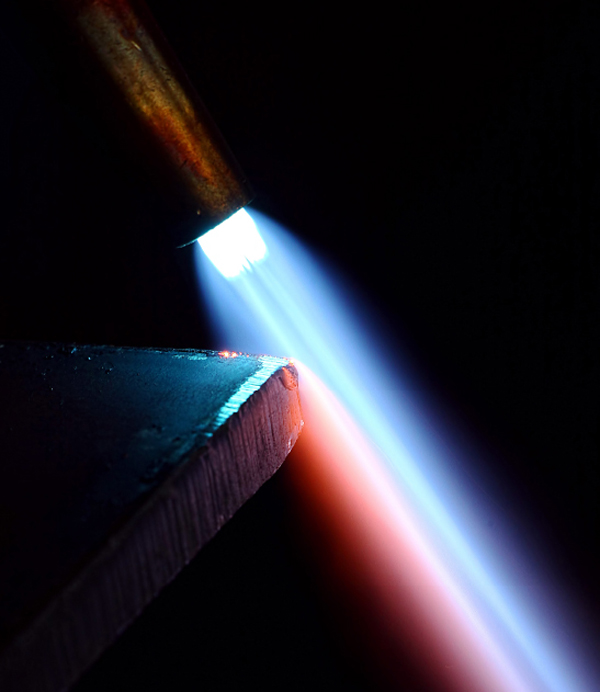1956
The Hottest Flame
Aristid V. Grosse (1905–1985)
All flames are not created equal. Their temperatures depend on several factors, for example, the bonds broken and formed in the combustion reactions, the amount of oxidant present (usually oxygen itself), and how well it mixes with the fuel. The familiar propane/oxygen flame can reach about 3,600 degrees Fahrenheit (2,000 degrees Celsius), and an acetylene flame can reach almost 6,000 degrees Fahrenheit (3300 degrees Celsius), but both these hydrocarbons have limits. Their hydrogen is oxidized to water vapor, which absorbs a large amount of heat. Above about 3,600 degrees Fahrenheit (2,000 degrees Celsius), water itself breaks down, absorbing still more heat as it does. To reach the highest temperatures, a flame would need to consist of oxygen and a substance without hydrogen. Alternatively, a strong oxidizer other than oxygen might do the trick.
Two of the hottest flames known fit these conditions perfectly. If you are so foolhardy as to mix hydrogen and fluorine, you will set off a vigorous reaction indeed (and produce clouds of hot, corrosive, toxic hydrogen fluoride as well, so be warned). This flame can reach just above 7,200 degrees Fahrenheit (4,000 degrees Celsius), although measuring it will be a challenge, since it will destroy most temperature probes. But the hottest flame of all is produced by the exotic compound dicyanoacetylene (also known as carbon subnitride). Its firepower was discovered by A. D. Kirshenbaum and Latvian-American chemist Aristid V. Grosse, who were studying the effects of high-temperature flames for aerospace applications, and described it in a 1956 paper. Dicyanoacetylene is not very stable—an explosion hazard under the best of conditions. But it has no hydrogen in its structure, and its combustion products are carbon monoxide and nitrogen gas, both of them very stable. Its flame with pure oxygen reaches 9,008 degrees Fahrenheit (4,987 degrees Celsius), temperatures within striking distance of the surface of the sun (9,900 degrees Fahrenheit, 5,500 degrees Celsius). But there could be something even fiercer: If anyone has reacted dicyanoacetylene with fluorine, it has not been reported. Stand back!
SEE ALSO Hydrogen (1766), Oxygen (1774), Gibbs Free Energy (1876), Isolation of Fluorine (1886), Acetylene (1892), Thermite (1893)

This acetylene cutting-torch flame is hottest at the tip of the bright white “inner cone” near its opening. Very few people have ever seen hydrogen/fluorine or oxygen/dicyanoacetylene flames, which is probably a good thing.